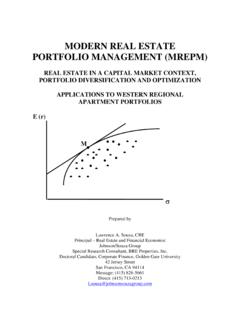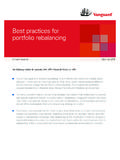Transcription of OPTIMIZATION OF THE NON-LIFE INSURANCE RISK ...
1 OPTIMIZATION OF THE NON-LIFE INSURANCE RISK. diversification IN solvency II. Werner H rlimann FRSG lobal Switzerland Bederstrasse 1, CH-8027 Z rich E-mail : Abstract According to the current solvency II standard approach, NON-LIFE risk capital charges take into account geographical diversification by adjusting volume measures using a Herfindahl- Hirschman concentration index for premiums and reserves at a line of business level. The lower the Herfindahl index the less concentrated is a portfolio and the greater is its diversification extent. The diversification factor of a portfolio of risks with respect to some risk measure is defined to be the quotient of the portfolio risk measure to the sum of the stand-alone risk measures over all risks in the portfolio.
2 Maximum diversification is obtained by minimizing the diversification factor. According to the QIS4 proposal the minimum diversification factor is equal to This value is not optimal. If the risk measure is proportional to the standard deviation of the risk, then the absolute minimum value of allows for an additional diversification reduction of maximum magnitude The latter is true in the case of the value-at-risk and the conditional value-at-risk measures for the class of multivariate elliptical risk distributions. However, the current solvency II standard approach to NON-LIFE risk relies on log-normal distributions. In this framework, the minimum diversification factor, which depends on the volatility of the portfolio, is in the average equal to , which results in an absolute diversification reduction of magnitude compared to QIS4.
3 Extending the analysis to the class of multivariate log-elliptical risk distributions, further results on the minimum diversification factor can be obtained. For the class of multivariate log-Laplace distributions, which are able to model fat tails similarly to the class of generalized Pareto distributions in Extreme Value Theory, this minimum value is in the average resulting in an absolute reduction of lower magnitude 7%. Key words solvency II NON-LIFE risk, value-at-risk, conditional value-at-risk, Herfindahl-Hirschman index, diversification factor, multivariate elliptical and log-elliptical risk distributions OPTIMIZATION OF NON-LIFE RISK diversification IN solvency II 2.
4 1. Introduction Though an old idea, the measurement and allocation of diversification in portfolios of asset and/or liability risks is a difficult problem, which has found so far many answers. The diversification effect of a portfolio of risks is the difference between the sum of the risk measures of stand-alone risks in the portfolio and the risk measure of all risks in the portfolio taken together, which is typically non-negative, at least for positive dependent risks . The risk allocation problem consists to apportion the diversification effect to the risks of a portfolio in a fair manner, to obtain new risk measures of the risks of a portfolio.
5 The first mathematical approach to diversification is due to Markowitz(1952/59/87/94), whose classical portfolio selection model applies to the efficient diversification of investments. The present paper considers only the diversification effect of a portfolio of NON-LIFE risks . According to the current solvency II standard approach, which is specified in QIS4(2008), NON-LIFE risk capital charges take into account geographical diversification by adjusting volume measures using a Herfindahl-Hirschman concentration index for premiums and reserves at a line of business level. The lower the Herfindahl index the less concentrated is a portfolio and the greater is its diversification extent.
6 While from a theoretical point of view the link between diversification and concentration has been somewhat studied in Foldvary(2006), the present contribution focuses on the practical relevance of diversification in the solvency II project. The diversification factor of a portfolio of risks with respect to some risk measure is defined to be the quotient of the portfolio risk measure to the sum of the stand-alone risk measures over all risks in the portfolio. Maximum diversification is obtained by minimizing the diversification factor. Observe that the greater the diversification reduction is, the less risk capital is needed and the more new business can be written.
7 Therefore optimal diversification has an important practical relevance. According to the QIS4 proposal the minimum diversification factor is equal to This value is not optimal. If the risk measure is proportional to the standard deviation of the risk, then the absolute minimum value of allows for an additional diversification reduction of maximum magnitude The latter is true in the case of the value-at-risk and the conditional value-at-risk measures for the class of multivariate elliptical risk distributions. However, the current solvency II standard approach to NON-LIFE risk relies on log-normal distributions. Under this assumption, the minimum diversification factor, which depends on the volatility of the portfolio, is in the average equal to , which results in an absolute diversification reduction of magnitude compared to QIS4.
8 Extending the analysis to the class of multivariate log-elliptical risk distributions, further results on the minimum diversification factor can be obtained. For the class of multivariate log-Laplace distributions, which are able to model fat tails similarly to the class of generalized Pareto distributions in Extreme Value Theory, this minimum value is in the average resulting in an absolute reduction of lower magnitude 7%. A more detailed account of the content follows. Section 2 reviews the solvency II. standard approach to NON-LIFE risks and presents a simple explanation for the proposed diversification factor, which is missing in QIS4(2008).
9 It is based on the intra-portfolio correlation coefficient. Section 3 derives the minimum value of the diversification factor for risk measures proportional to the standard deviation of the risks . Typically, the obtained result applies to the class of multivariate elliptical distributions. A rigorous approach to the current standard solvency II approach is found in Section 4, where minimum diversification factors are derived for the class of multivariate log-normal distributions. Section 5 extends the results of Section 4 to multivariate log-elliptical distributions, and exemplifies the results for the class of multivariate log-Laplace distributions.
10 Finally, Section 6 illustrates the numerical impact of our findings on the current solvency II standard approach. OPTIMIZATION OF NON-LIFE RISK diversification IN solvency II 3. 2. solvency II NON-LIFE risk diversification according to QIS4. Recall the simple actuarial rationale for the NON-LIFE economic capital formula proposed for solvency II in QIS3(2007), which has been presented in H rlimann(2008a). Suppose an INSURANCE risk portfolio over a fixed time period, say over a one-year time period [0,1] between the times t = 0 and t = 1 , is described by the following quantities: P : the (net) risk premium of the portfolio for the time period S : the random aggregate claims of the portfolio over the time period While the risk premium is supposed to be known at the beginning of the period, the random aggregate claims are not.






